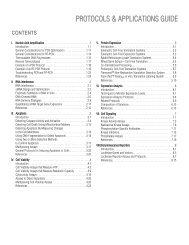2012 Promega catalogue
2012 Promega catalogue
2012 Promega catalogue
You also want an ePaper? Increase the reach of your titles
YUMPU automatically turns print PDFs into web optimized ePapers that Google loves.
Cell Signaling<br />
CaspACE Assay System, Colorimetric<br />
Product Size Cat.# Price ($)<br />
CaspACE Assay System, Colorimetric 50 assays G7351 450.00<br />
For Laboratory Use.<br />
100 assays G7220 703.00<br />
Description: The CaspACE Assay System, Colorimetric, provides reagents<br />
for measuring caspase-3 activity. The system includes a colorimetric substrate<br />
and a cell-permeant inhibitor that allow quantitative measurement of caspase-3<br />
(DEVDase) protease activity. The colorimetric substrate (Ac-DEVD-pNA) is<br />
labeled with the chromophore p-nitroaniline (pNA). pNA is released from the<br />
substrate upon cleavage by DEVDase. Free pNA produces a yellow color that is<br />
monitored by a spectrophotometer at 405nm. The amount of yellow color produced<br />
is proportional to the amount of DEVDase activity present in the sample.<br />
The potent, irreversible and cell-permeant pan-caspase inhibitor Z-VAD-FMK<br />
is provided in the CaspACE Assay System, Colorimetric. The addition of the<br />
Z-VAD-FMK Inhibitor prior to the induction of apoptosis in cell culture inhibits<br />
the activation of the caspase cascade, including caspase-3.<br />
Features:<br />
• Timely: Measures an early indicator of apoptosis.<br />
• Quantitative or Qualitative: Determine total caspase-3 activity or screen<br />
for inducers or inhibitors of caspase activity.<br />
• Versatile: May be used with purified enzyme preparations, cell extracts or<br />
tissue lysates.<br />
Storage Conditions: Store at –20°C. Store substrates and inhibitors in<br />
aliquots at –20°C away from light and moisture.<br />
Protocol Part#<br />
CaspACE Assay System, Colorimetric Technical Bulletin TB270<br />
CaspACE FITC-VAD-FMK In Situ Marker<br />
Product Size Cat.# Price ($)<br />
CaspACE FITC-VAD-FMK In Situ Marker 50 µl G7461 343.00<br />
For Research Use Only. Not for Use in Diagnostic Procedures.<br />
125 µl G7462 717.00<br />
Description: CaspACE FITC-VAD-FMK In Situ Marker is a fluorescent<br />
analog of the pan caspase inhibitor Z-VAD-FMK (carbobenzoxy-valyl-alanylaspartyl-[O-methyl]-fluoromethylketone).<br />
The fluorescein isothiocyanate (FITC)<br />
group has been substituted for the carbobenzoxy (Z) N-terminal blocking group<br />
to create the fluorescent apoptosis marker. This structure allows delivery of the<br />
inhibitor into the cell where it irreversibly binds to activated caspases. The FITC<br />
label enables a single-reagent addition to assay for caspase activity in situ. The<br />
FITC-VAD-FMK is supplied as a 5mM solution in DMSO and is intended for in<br />
situ monitoring of caspase activity by fluorescence detection. The suggested<br />
concentration for use in anti-Fas-treated Jurkat cell culture is 10μM.<br />
Features:<br />
• Simplify Your Protocol: Add FITC-VAD-FMK, incubate, wash and view<br />
fluorescence. No preparation of cell extracts or long incubations.<br />
• Use a Variety of Detection Methods: Detect apoptotic cells by microscopy<br />
or flow cytometry; combine with other markers to assess cell populations<br />
or determine apoptotic frequency within a population; adaptable to<br />
high-throughput applications.<br />
• Get Reliable Results: Synthesized peptide provides consistent results<br />
from every batch, unlike Annexin V, which can be highly variable between<br />
batches.<br />
• Use With Live Cells: Easily moves in and out of cells and remains<br />
anchored inside cultured apoptotic cells.<br />
Storage Conditions: Store at –20°C protected from light and moisture.<br />
Protocol Part#<br />
CaspACE FITC-VAD-FMK In Situ Marker Protocol 9PIG746<br />
For complete and up-to-date product information visit: www.promega.com/catalog<br />
DeadEnd Colorimetric TUNEL System<br />
Product Size Cat.# Price ($)<br />
DeadEnd Colorimetric TUNEL System 20 reactions G7360 444.00<br />
40 reactions G7130 698.00<br />
For Research Use Only. Not for Use in Diagnostic Procedures.<br />
Description: The DeadEnd Colorimetric TUNEL System is a modified TUNEL<br />
Assay designed to provide simple, accurate and rapid detection of apoptotic<br />
cells in situ at the single-cell level. The DeadEnd Colorimetric TUNEL System<br />
measures nuclear DNA fragmentation, an important biochemical indicator of<br />
apoptosis. The system can be used to assay apoptotic cell death in tissue sections<br />
and cultured cells. The DeadEnd Colorimetric TUNEL System end-labels<br />
the fragmented DNA of apoptotic cells using a modified TUNEL (TdT-mediated<br />
dUTP Nick-End Labeling) assay. Biotinylated nucleotide is incorporated at the<br />
3´-OH DNA ends using the enzyme Terminal Deoxynucleotidyl Transferase (TdT).<br />
Horseradish-peroxidase-labeled streptavidin (Streptavidin HRP) is then bound<br />
to these biotinylated nucleotides, which are detected using the peroxidase substrate,<br />
hydrogen peroxide, and the stable chromogen, diaminobenzidine (DAB).<br />
Using this procedure, apoptotic nuclei are stained dark brown.<br />
Features:<br />
• Assay Cells or Tissue: Detect apoptosis in thick tissue sections or assess<br />
cell morphology.<br />
• Simplify: Includes DAB substrate and H 2O 2 for color detection and plastic<br />
coverslips that simplify sample handling.<br />
• Proven Applications: Vibratome ® sections of neuronal tissue, Jurkat<br />
cells, HL-60 cells.<br />
Storage Conditions: Store the Equilibration Buffer, TdT Enzyme, Biotinylated<br />
Nucleotide Mix and Proteinase K at –20°C. Store the Streptavidin HRP, DAB<br />
20X Chromogen, DAB Substrate 20X Buffer and Hydrogen Peroxide 20X at<br />
4°C. Store the SSC 20X and Plastic Coverslips at room temperature.<br />
Protocol Part#<br />
DeadEnd Colorimetric TUNEL System Technical Bulletin TB199<br />
31<br />
2<br />
Cell Health Assays<br />
Section<br />
Contents<br />
Table of<br />
Contents
















